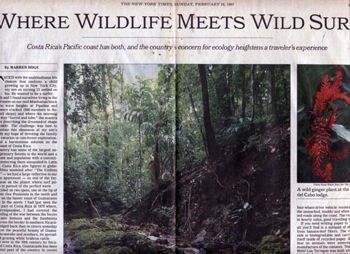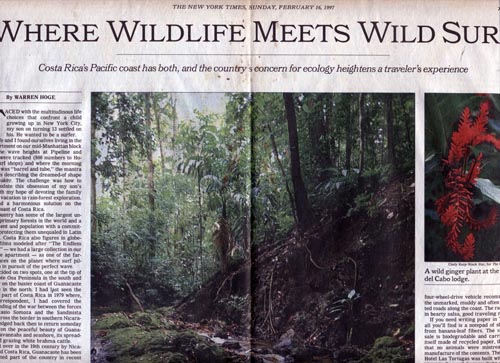
Where Wildlife Meets Wild Surf
Text by Warren Hoge
Costa Rica’s Pacific coast has both, and the country’s concern for ecology heightens a traveler’s experience. Faced with the multitudinous life choices that confront a child growing up in New York City, my son on turning 13 settled on his. He wanted to be a surfer
My wife and I found ourselves living in the only apartment on our mid-Manhattan block where the wave heights at Pipeline and Waikiki were tracked (800 numbers to Honolulu surf shops) and where the morning greeting was “barrel and tube,” the mantra of surfers describing the dreamed of shape of a breaker. The challenge was how to accommodate this obsession of my son’s along with my hope of devoting the family summer vacation to rain-forest exploration. We found a harmonious solution on the Pacific coast of Costa Rica.
The country has some of the largest untouched primary forests in the world and a government and population with a commitment to protecting them unequaled in Latin America. Costa Rica also figures in globe-trotting films modeled after “The Endless Summer”- we had a large collection in our East Side apartment- as one of the far-flung places on the planet where surf pilgrims go in pursuit of the perfect wave.
We decided on two spots, one at the tip of the remote Osa Peninsula in the south and the other on the busier coast of Guanacaste Province in the north. I had last seen the northern part of Costa Rica in 1979 where, as a correspondent, I had covered the bloody ending of the war between the forces of Anastasio Somoza and the Sandinista rebels across the border in southern Nicaragua. I pledged back then to return someday to focus on the peaceful beauty of Guanacaste’s savannahs and seashore, its spread-trees and grazing white brahma cattle.
Fought over in the 19th century by Nicaragua and Costa Rica, Guanacaste has been a conflicted part of the country in recent times. It served as a staging area for the Sandinista revels in the 1970’s, and in the 1980’s it became the site of secret airstrips and supply centers for the contras who sought to oust the victorious Sandinistas from Managua.
Osa, on the other hand, had always been cut off from the world and even from the rest of Costa Rica. A dirt road linking the peninsula to the mainland was completed only in 1986.
Our group was my wife, Olivia; my son, Nicholas, the soi-disant surfer; his schoolmate Wyndham Boylan-Garnett; Wyndham’s mother, Nuala Boylan, and myself. We flew to San Jose in August, where we overnighted at the Gran Hotel Costa Rica, a raffish downtown hotel with an open colonnaded restaurant looking out on the city’s busiest square, where we reporters had put up in 1979.
Bordered by the Teatro Nacional, a tropical knockoff of the Paris Opera House, the square is called the Plaza de la Cultura. But not all of its denizens are opera buffs. One of them that Saturday night stole a bag with all of my family’s passports, travel vouchers and credit cards.
After some hurried phone calls to start the process of getting passports replaced, credit cards canceled and copies of travel documents faxed, we set out the next day on a five-hour drive to Tamarindo…….
At week’s end we drove back to San Jose, gave up our vehicle and caught our flight to Puerto Jimenez, the only town on the Osa Peninsula. Waiting for us by the gravel airstrip was Jonathan Seidman, a 27-year-old forestry and conservation graduate of Kent State University who has worked there as a guide for five years, with whom we had made arrangements five months earlier.
He drove us into town, a laid-back frontier outpost with a soccer field, a boat dock and the only block of paved road on the entire peninsula. We bought flashlights and simple knee-high rubber boots for the rain-forest treks, then drove out along the coast of the Golfo Dulce and up muddy roads to our lodge, Bosque del Cabo.
Bosque sits in a privileged location, 500 forested feet above the Pacific. Its seven thatched-roof bungalows have porches that look out over the ocean. The beds are covered in mosquito netting, but it’s a largely decorative touch. At that height, the nights are breezy and bug-free. Once a cattle pasture, the land has been gracefully landscaped with profusions of brightly colored gingers and heliconias lining the pathways from the individual lodgings to the one communal space, a dining area open to the sides.
The only contact with the outside world is by radio phone, and there is electricity only in the kitchen. Night falls early in Costa Rica in summer, usually about 6 P.M., and from that hour on, Bosque lives by candlelight. The hiking during the day is very physical. You are apt to feel total bone fatigue and find yourself nodding off by 8 P.M. I loved the idea of reading by the light of a flickering flame in the midst of a forest, but each night I was good for only a couple of pages.
Our purpose in going to Bosque was to live in, feel and try to understand some of the complexities of the tropical rain forest, and Jon wasted no time getting us on the trail. Many times it wasn’t a trail at all, but a slurry of leaves and mud and rocks, and the inclines and descents were steep. Within minutes of leaving Bosque our first afternoon, Jon announced that we were in primary forest, undeveloped, undisturbed, its reproductive cycles intact and humming.
We found ourselves at the base of immense trees, some rising 180 feet above the forest floor, closing out all but about 10 percent of the light shining down on the canopy. The sight induced a feeling of wonder and reverence. The great cathedral-like space captured the forest’s mists and held them in the shards of sunlight, like fine particles of dust that hang suspended in the streaks of light shining through stained-glass windows in great naves.
The profound silence was a quietness that throbbed with activity as Jon pointed out all the life going on around us- hummingbirds pollinating the voluptuous orange and red heliconia plants, cowtrees (so called because when cut with a knife they secrete a digestive latex), larvae of frogs and tadpoles in tightly joined leaf bases where water had collected, earnest parades of leafcutting ants carrying their immense burdens from trees to anthills, golden silk orb-weavers spinning perfectly symmetrical lace patterns, mimosa leaves that fold in on themselves protectively on being touched, strangler-fig vines reducing the tree they have encircled to a home for ants, moths and bats, Indian desnudio trees that continually shed their bark so that parasitic plants can’t take up lodging, woodpeckers tapping away in pursuit of termites.
During our treks, giant frigate birds with their wingspans of more than six feet wheeled into view overhead. Lovely little immaculate antbirds called out to one another in sweet bell tones, laughing falcons guffawed and, in the forest counterpart to hoisting the cocktail flag, parrots, the most social of birds, gathered in flocks at day’s end and raised a happy ruckus.
There are four kinds of monkeys in this part of the rain forest- squirrel, spider, white-faced capuchin and howler- and we saw them all. The howlers put up a sonorous groan, using their formidable sound equipment and then amplifying it with a bellows-like movement of their jowls. The spiders chatter excitedly and perform spectacular acrobatics in the trees. All of them get irritated at the presence of someone else. They shake their fist at you. They also shake tree limbs and have been known to throw things at people, ranging from fruit pits to their own feces.
We swam in waterfalls and splashed in pools in reef formations on the beach that emerge as the tide ebbs, producing a whirlpool-bath effect. We walked on beaches where the only signs of human life were our own footprints, and we hiked the forest paths in the midst of thunderstorms and marveled at how little rain fell on us.
One morning we were accompanied by a dazzling blue morpho butterfly that sashayed with the studied insouciance of a boulevardier showing off his chic. These were not he only popinjays out that day. Toucans and fiery-billed aracaris posed on three limbs proudly showing their golden-beaked profiles, and scarlet macaws flew by, shrieking and flashing their red plumage.
One afternoon, Jon spotted a hugely feathered brown and black bird on a low tree limb. It was a giant curassow, a sight so rare that Jon demanded we take his picture with it so that his friends would believe he had really seen one.
Detached from the world, deep into the mysteries of nature in the raw, we grew to feel the kind of out-of-office sensation the best vacations deliver. But the real test of that phenomenon came when we were joined in the lodge by a Hollywood producer, Brain Grazer, whose film, “The Nutty Professor,” had recently been released. He hiked and surfed and watched rosy sunsets behind thunderheads on the Pacific horizon from his porch hammock like the rest of us. Three days passed. But on the fourth day he sent someone to town to fax his studio and get the grosses.


